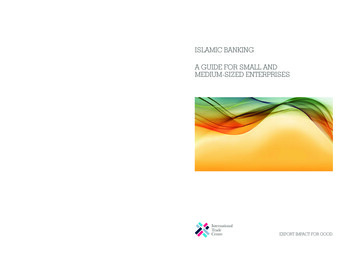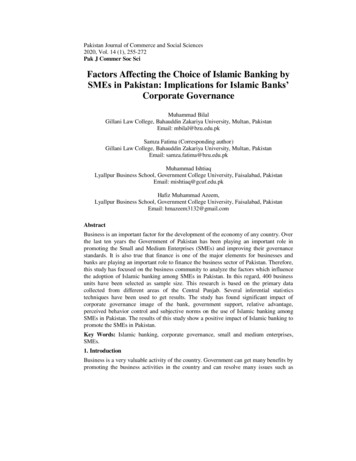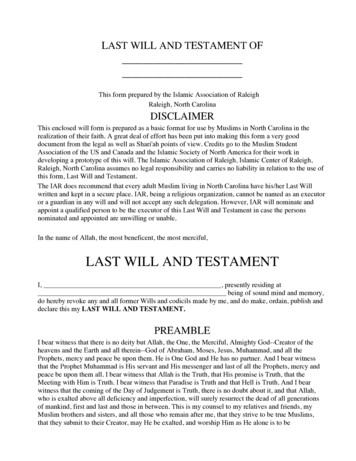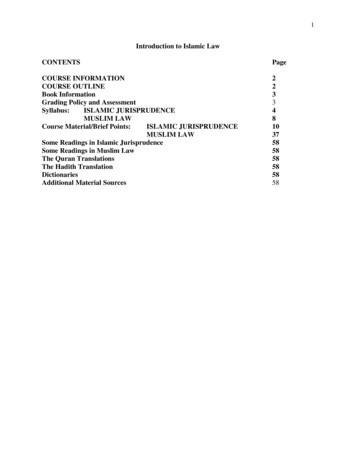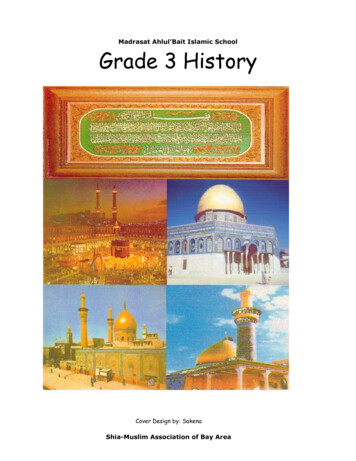
Transcription
Madrasat Ahlul’Bait Islamic SchoolGrade 3 HistoryCover Design by: SakenaShia-Muslim Association of Bay Area
First EditionFirst PrintingSecond Printing(Revision 2.0)May, 2005February, 2006Compilers and Co-Authors:Samina Ali, Member, Syllabus Committee,Madrasat Ahlul’Bait, Shia-Muslim Association of Bay AreaEditors:Samina Ali, Member, Syllabus Committee,Madrasat Ahlul’Bait, Shia-Muslim Association of Bay AreaCopyright Free & Non-Profit Notice:Madrasat Ahlul’Bait curriculum material can be freely copied, duplicated, reproduced, quoted,distributed, printed, used in derivative works and saved on any media and platform for non-profitand educational purposes only. A fee no higher than the cost of copying may be charged for thematerial.Note from Madrasat Ahlul’Bait:The Publishers and the Authors have made every effort to present the Quranic verses, propheticand masomeen traditions, their explanations and the material from the sources referenced in anaccurate, complete and clear manner. We ask for forgiveness from Allah (SWT) and the readers ifany mistakes have been overlooked during the review process.Contact Information:Any correspondence related to this publication and all notations of errors or omissions should beaddressed to Syllabus Committee, Madrasat Ahlul’Bait, Shia-Muslim Association of Bay Area atsaba@saba-igc.org.Published by:Madrasat Ahlul’BaitShia-Muslim Association of Bay Area4415 Fortran Court, San Jose, CA 95134, USAwww.saba-igc.orgsaba@saba-igc.orgLIMIT OF LIABILITY/DISCLAIMER OF WARRANTY: THE PUBLISHER AND THE AUTHORS MAKE NO REPRESENTATIONSOR WARRANTIES WITH RESPECT TO THE ACCURACY OR COMPLETENESS OF THE CONTENTS OF THIS WORK ANDSPECIFICALLY DISCLAIM ALL WARRANTIES, INCLUDING WITHOUT LIMITATION WARRANTIES OF FITNESS FOR APARTICULAR PURPOSE. NO WARRANTY MAY BE CREATED OR EXTENDED BY SALES OR PROMOTIONAL MATERIALS.THE ADVICE AND STRATEGIES CONTAINED HEREIN MAY NOT BE SUITABLE FOR EVERY SITUATION. NEITHER THEPUBLISHER NOT THE AUTHORS SHALL BE LIABLE FOR DAMAGES ARISING HEREFROM. THE FACT THAT ANORGANIZATION, BOOK OR WEBSITE IS REFERRED TO IN THIS WORK AS A CITATION AND/OR A POTENTIAL SOURCEOF FURTHER INFORMATION DOES NOT MEAN THAT THE AUTHORS OR THE PUBLISHER ENDORSES THEINFORMATION THE ORGANIZATION OR WEBSITE MAY PROVIDE OR RECOMMENDATIONS IT MAY MAKE. FURTHER,READERS SHOULD BE AWARE THAT BOOKS AND INTERNET WEBSITES LISTED IN THIS WORK MAY HAVE CHANGEDOR DISAPPEARED BETWEEN WHEN THIS WORK WAS WRITTEN AND WHEN IT IS READ. SHIA ASSOCIATION OF BAYAREA IS NOT ASSOCIATED WITH ANY ORGANIZATION, PRODUCT OR VENDOR MENTIONED IN THIS BOOK.2Grade 3 History
Table of ContentsTable of Contents .3Foreword .5Preface.6SECTION I: Islamic History.7Chapter 1: Aamul Feel (The Year of the Elephant) .81.1Worksheet: Aamul Feel: (The Year of the Elephant): .9Chapter 2: Bibi Khadija.102.1Worksheet: Bibi Khadija .12Chapter 3: Salman Al-Farsi (a.r.).133.1Worksheet: Salman Al-Farsi .15Chapter 4: Adhan .174.14.2The First Mu’adhim .17Worksheet: Adhan.18Chapter 5: The Month of Rajab .195.1Worksheet: Month of Rajab .20Chapter 6: Eid-ul-Hajj.216.1Worksheet: Eid ul-Hajj.23Chapter 7: Eid-e-Ghadeer.247.1Worksheet: Eid-e-Ghadeer .26Chapter 8: Eid-e-Mubahila.298.1Worksheet: Eid-e-Mubahila .30Chapter 9: Bibi Maryam.319.1Worksheet: Bibi Maryam .33Chapter 10:Islamic holy cities in Saudi Arabia .3410.1 Mecca al-Mukarramah .3410.1.1Jannat al-Mualla (Cemetery in Mecca) .3410.2 Medina al-Munawwarah .3510.2.1Masjid al-Nabawi .3510.2.2Jannatul Baqi .3510.2.3Masjid Quba: .3510.2.4Masjid Qiblatayn (i.e. the mosque of two qiblas) .3610.3 Arafat.3610.3.1Jabal Rahmah .3610.3.2Masjid Numrah.3610.4 Mina .36Chapter 11:11.111.2Chapter 12:Chapter 13:13.1The Islamic holy cities in Iraq .37Najaf .37Kufa .38Masjid Kufa.38House of Imam Ali, peace be upon him .38Kerbala .39Grade 3 History3
13.213.3Kadhmayn .39Samarra.40Chapter 14:14.114.2Chapter 15:15.115.2Baitul Muqaddas .44Ashaabul Kahf - The People of the Cave .46Worksheet: People of the Cave – Ashaabul Kahf .49Chapter 18:18.1Islamic holy cities in Syria.42Damascus .42Prison.43Chapter 16:Chapter 17:17.1Islamic holy cities in Iran.41Mashad al-Muqaddas .41Qum.41The people of Raas.51Worksheet: People of Raas .53SECTION II: Special Occasions.54Chapter 19: Friends of Imam Hussein (a) .5519.119.219.319.419.519.6Hur bin Yazid ar-Riyaahi .55Muslim bin ‘Awsaja al-Asadi .56Abu Thumaama al-Sa’idi .56Sa’id bin Abdallah al-Hanafi.57Zuhayr bin Qayn bin Qays al-Bajali .57Worksheet: Friends of Imam Hussein (a) .58Chapter 20:20.1Worksheet: Martyrdom of sons of Muslim bin Aqeel (a) .63Chapter 21:21.121.221.321.4Events after the Day of Ashura.64The Journey to Damascus .64The Journey from Kufa to Damascus.65The Court of Yazid.65Worksheet: Events after the Day of Ashura.67Chapter 22:22.122.222.322.422.522.6The Tragedy of Kerbala: Sons of Muslim bin Aqeel (a) .61Understanding Kerbala .68Prophet Muhammad’s (s) Family Tree .68Maps of the Middle East .70Route of Imam Hussein (a) .71Events at Kerbala .72ASHURA Day.73Worksheet: Understanding Kerbala .74Acknowledgements .764Grade 3 History
In the Name of Allah the Most Gracious Most MercifulForewordThe material presented in this document is a result of an effort made by the personnel of theschool of Ahlul’Bait of the Shia-Muslim Association of Bay Area Islamic Center at San Jose,California in cooperation with several schools of Ahlul’Bait at London-Stanmore, London-Hujjat,Vancouver, Minnesota and Toronto.We, at San Jose, looked at material from London-Stanmore, London-Hujjat, Vancouver,Minnesota, Toronto and Irvine's Islamic institutions, as well as that available at various web-sitesto compile age appropriate textbooks for use by our students. We thank the institutions that werekind enough to provide us with the electronic files of their curriculum. We used some of what theyhad and added to it what we felt was appropriate. We included more worksheets and pictureswhere deemed necessary. We also added some new topics that, we felt are important to thestudents.We had two important goals in mind while working on this document. First, introduce the studentsto the important Islamic concepts and beliefs that are crucial for him/her to know. Second, exposethe students to as many Quranic verses and sayings from Prophet Muhammad (p) and hisAhlul’Bait (a) as possible.We thank Hujjatul Islam Maulana Nabi Raza Abidi for his spiritual guidance. We hope futureefforts will continue taking place until reaching our goal of having a strong, rich and unifiedcurriculum for the schools of Ahlul’Bait for all ages.Syllabus CommitteeMadrasat Ahlul’BaitGrade 3 History5
PrefaceNow that the students have been introduced to the Islamic Calendar, some of the past prophetsand the 14 Ma‘sumeen (a), they will now cover history related themes so as to familiarize andenhance their understanding in these issues. Many of the themes will be covered in the Islamicmonths when these events have taken place. Eeds and another five lessons on Islamic holy citiesare introduced. Lessons on Kerbalaa’ continues in this grade6Grade 3 History
SECTION I: Islamic HistoryGrade 3 History7
Chapter 1: Aamul Feel (The Year of the Elephant)In 570 AD, the year of the birth of our Holy Prophet (p), a Christiangovernor called Abraha marched to Makka to destroy the HolyKa'aba. He wanted to destroy the Ka'aba, because he wantedpeople to come and worship at a huge church he had built in Yemen.Abraha's army also had elephants, which wasn’t very common inArabia. History calls this army "Ashabul Fíl" or "The People of theElephant".When he reached Makka, he captured some camels belonging to the chief of Makka, AbdulMuttalib, the grandfather of the Holy Prophet (S). When Abdul Muttalib went to see him,Abraha thought he would ask him to spare the Holy Ka'aba. Instead, Abdul Muttalib asked forthe camels to be returned.Abraha laughed and said, "What! I have come to destroy your place of worship, and you arespeaking of your camels!" Abdul Muttalib gave a famous reply, "I am the owner of thecamels, so I have come for them. The Ka'aba too has an Owner, Who will look after it"On his return, Abdul Muttalib ordered the people to leave Makka and go to the hills for safety.He then prayed to Allah to protect them and the Holy Ka'aba from any harm.The next morning Abraha prepared to march towardsMakka. All of a sudden, a flock of birds appeared from theside of the sea, holding tiny stones in their claws andbeaks.Each bird held three stones and they showered the stoneson the army of Abraha in such a way that many men andelephants were soon dead. One of the stones hit Abrahaon his head and he was so frightened that he ordered theremaining men in his army to retreat at once.Many of his men died on the way back and Abraha himself died a painful death. This event ismentined in the Holy Qur'an in Suratul Feel, Verses 1-58Grade 3 History
1.1 Worksheet: Aamul Feel: (The Year of the Elephant):“I am the owner of the camels.The House too has a Master who looks after it.”1. Who said the above famous saying?2. Which House was he talking about?3. Draw this House:4. Who is the Master of this House?5. Now draw what happened to Abraha's army of elephants.Grade 3 History9
Chapter 2: Bibi KhadijaBibi Khadija was the first wife of Prophet Muhammad (p), and the mother of Bibi Fatimah (a).Her father was a wealthy trader. When herBibi Khadija (a) continued his business oftrade caravans to Syria and Yemen. Soonrichest trader in Mecca and was known asMecca".father died,sendingshe was the"Princess ofProphet Muhammad (p) worked for Bibi Khadija, she liked his honesty and the way he treatedpeople They soon they were married. At the time of their marriage the Holy Prophet (S) was 25years old while Bibi Khadija (a) was 40 years of age.The Holy Prophet (S) and Bibi Khadija (a) were blessed with two boys. The first of whom wasQasim and the second Abdullah. Both boys died while still very young. This made the HolyProphet (S) very sad and when his cousin Imam Ali (a) was born, he brought him up in hishouse as his own son.The Holy Prophet (p) and Bibi Khadija then had adaughter, Bibi Fatimah (a).Prophet Muhammad (p) used to spend a lot of time in acave on Mount Hira near Makka. There, he would thinkabout Allah and wonder at His creations.Sometimes he would stay on Hira for many days at a time.Bibi Khadija would regularly visit him, bringing food and water and making sure he wascomfortable.When Prophet Muhammad (p) was finally commanded by Allah to begin teaching Islam, BibiKhadija was the first woman to accept his message and become a Muslim. She gave all hermoney to help spread Islam.10Grade 3 History
Bibi Khadija was married to the Holy Prophet (p) for many years before she died. She isburied in Makka.The Prophet’s uncle, Abu Talib also died in this year that has been named the “Year of Grief”or“Aamul Huzn” in Arabic.While Bibi Khadija was alive, the Holy Prophet (p) did not marry another woman, and later saidthat she was the best of his wives.He also said that she was one of the 4 perfect women who had ever lived. The otherthree are:- Bibi Asiya (wife of Firaun)- Bibi Maryam (mother of Prophet Isa), and- Bibi Fatimah (a)Grade 3 History11
2.1 Worksheet: Bibi KhadijaCrossword on Bibi Khadija:123546ACROSS1. The name of the daughter of Bibi Khadija.2. The name of the wife of the Holy Prophet (p) who is known as one of the four perfectwomen in the world.3. The name of the year in which Bibi Khadija died.DOWN4. The burial place of Bibi Khadija.5. The name of the mountain where the Holy Prophet often went to meditate.6. The name of one of her sons who died while still young.Bibi Khadija was the richest trader in Mecca and was known as the12Grade 3 History
Chapter 3: Salman Al-Farsi (a.r.)Salman was born in a small town in Persia (Iran) called Jiyye. His Persian name was Rozeba.He was born into a Zoroastrian family (who worshipped fire although the sixth Imam has saidthat Salman never did shirk). Once he was sent out of his hometown by his father for anerrand. He saw a church and heard(voices. He went in and enquired and accepted the beliefof one God andProphet Isa (a) as a Prophet (At that time there was no trinity within Christianity). When hereturned home and revealed to his father his acceptance of Christianity, his father was furiousand punished him putting him in a dark dungeon.Eventually freed by his Christian friends he joined a caravan and left Iran. When on thecaravan he refused to eat dead animal meat and drink wine. The people of the caravan soldhim to a Jew who made him work very hard. His master sold him to another Jew who lived inQuba (near Medina).Salman was in search of the truth and the Prophet 'who was going to come (as he had learntin Christianity). One day he overheard his master talking of the Prophet and heard that he (theProphet) was on his way to Medina. When he heard of the Prophet's arrival in Quba Salmanwent to meet him. Salman had read of the signs of a Prophet (i) Does not accept Sadaqa.(ii) Does not return gifts.(iii) Mark between shoulders.Salman took dates as Sadaqa and noticed that the Prophet did not eat them. He also saw acloud over the Prophet. .When he visited Medina again he took dates as a gift and noticed that the Prophet acceptedthem. The third sign was apparent to him when be accompanied a funeral with the Prophetand saw the mark of Prophethood when the breeze moved the Prophets cloak.Salman accepted Islam and the Prophet's Prophethood.One day the Prophet visited Salman who was ill. He prayed for him that Allah keep him farfrom all 'ills' (body & soul) till death. Therefore the name from there - Salman (Safety).In Medina when the Prophet arranged brotherhood, Salman was made the brother of AbuDharr Ghifari.\\'hen Salman's Jewish master found that Salman had accepted Islam he did not like it andGrade 3 History13
was cruel to him. Salman wished to be a free man. For his freedom his master wanted 30-40young date palms and 4oz of gold. He told the Prophet who requested the other Muslims tohelp. Soon with the help Salman was free.Salman learnt as much as he could from the Prophet, at times spending whole nights withhim. He learnt perfect Arabic and translated the Qur'an into Persian for his countrymen. Nextto Imam Ali (a) there was none to match his bravery and knowledge.The Prophet (P) called him:"The first gift of Persia (Iran) to Islam".It was Salman who advised the digging of the ditch around Medina in the battles of Khandaq.\Vhen the ditch was being dug both Ansars & Muhajirs claimed that Salman was one of thembut the Prophet said:"Salman is neither an Ansar nor a Muhajir but is one of us - the people of the house(Ahlulbayt)".After the battle of Khandaq, the Muslims went to Taif where the people had enclosedthemselves into walls. Salman taught the using of rocks in 'slings' to break the waIls and Taifwas won over.The Prophet's death grieved Salman immensely and he cried continuously. He loved andserved Imam Ali (a)He was sent by one of the Khalifas for the conquest of Iran. With Imam· Ali's permission hewent and Iran was defeated. It was Salman who was entrusted to distribute the vast bootywhich was acquired from there.With Imam Ali’s permission Salman accepted the govemership of Madaen.Nearing his death he asked Asbagh bin Nubata (another companion) to take him to thecemetery of Madaen where he talked to a corpse about death. He told Asbagh that he was todie soon and recited Kalima.Imam Ali (a) came from Medina to give ghusl and kafan to Salman and he was buried by Imamin Madaen.14Grade 3 History
3.1 Worksheet: Salman Al-Farsi1. Salman Al-Farsi was born in a family thata.b.c.d.Worshipped flowersWorshipped idols (Buddhist)Worshipped fire (Zoroastrian)Worshipped only one God (Muslim)2. Salman Al-Farsi later converted toa.b.c.d.ChristianityBuddhismHinduismJudaism3. Which one according to Salman was NOT a sign of the Propheta.b.c.d.Does not accept SadaqaDo not return giftsMark between shouldersAlways wears expensive clothes4. n Medina when the Prophet arranged brotherhood, Salman was made brother ofa.b.c.d.Ali ibn Abu TalibAbu Dharr GhifariAmmar YassirJabir Ibn Abdullah5. The prophet said, “Salman is neither an ANSAR nor a MUHAJIR but isa.b.c.d.One of us (the people of the house, AHLULBAYT)The best looking person in MedinaMan from IranOne of the MeccanGrade 3 History15
6. In Imam Ali’s period, Salman Al-Farsi was governor ofa. San Joseb. Meccac. Madaend. Taif7. came from Medina to give ghusl and kafan to Salmana. Prophet Muhammad (s)b. Imam Ali (a)c. Imam Hassan (a)d. Abu Dharr Ghifari16Grade 3 History
Chapter 4: AdhanAdhan is the call to Salaat. When someone hears the Adhan they know that the time for Salaathas set in.There are 5 Salaat which are Wajib – we have to pray them. Each of these Salaat have a specialtime when they should be prayed.The Adhan lets everyone know that it is that special time when they have to pray their Salaat.Allah likes very much for us to say Adhan before we begin Salaat, even if it is not exactly whenthe time has set in.When you were born each one of you had Adhan said in your right ear and Iqamah in your leftear.If Adhan is being said you should say it with the person saying it, but softly.4.1 The First Mu’adhimThe Prophet (s) was looking for a way to announce the time of salaa. After the masjid in Medinawas built, people came to pray Salatul Jama’a regularly but were often late. To be able to find outthe time for salaa they had to look at the sun. There were no clocks or watches at the time.Lots of different ideas were put forward. Some people suggested a trumpet or a bell theProphet (s) did not like any of these ideas.It was then Jabrail came down with the Adhan chosen by Allah for the announcement of Salaa.The Prophet (s) taught the Adhan to Imam Ali (a) and told him to teach it to Bilal.Bilal was appointed for the duty of calling Adhan. He had a loud and clear voice.Bilal was therefore the first Mu’adhim of Islam. Mu’adhim is one who calls outAdhan.Grade 3 History17
4.2 Worksheet: AdhanFill in the blanks.1.2.3.4.is the call to Salaat.Wajib salats are in number.was the first Muadhin of Islam.Angel -came down with the Adhan chosen by Allah for theannouncement of salat.5. taught Adhan to Bilal.18Grade 3 History
Chapter 5: The Month of RajabRajab is one of the four months declared sacred by Allah in the Holy Qur’anThe Prophet Muhammad (s) is reported to have said that the month of Rajab is the month whenAllah’s mercy descends on His creation like gentle rain. He further said that it is the month ofIstighfar – a month when one should seek forgiveness of sins.It is highly recommended to fast in the month of Rajab. Recite Surah Al-Ikhlas at least 100 times(1000 or 10000 times will accrue more rewards) in the month of Rajab.It is also said that there is a river in Janna called Rajab which is whiter than milk and sweeter thanhoney. The Prophet Muhammad (s) has said that he / she who fast in this month will drink fromthis river.Grade 3 History19
5.1 Worksheet: Month of RajabWrite the recommended deeds for the month of Rajab in the circles:Rajab20Grade 3 History
Chapter 6: Eid-ul-HajjEid ul-Haj is also known as Eid ul-Adha (Eid of Sacrifice).It takes place on the 10th of Dhulhijja, and marks the end of Haj ofMuslims to Makka.This Eid honours the sacrifice of Prophet Ismail by his father, ProphetIbrahim.One day, Prophet Ibrahim dreamt that he was sacrificing his young son, Prophet Ismail. Thisday is called Yawme Tarwiyah which means, the Day ofthe FirstAllah’sDream.commandsProphet Ibrahim often received Allah'shis dreams, but because he was being askedhis son, he wondered whether it was real.commands into actually killHe had the same dream the next day, and was now sure it was a true command.So, the 9th of Zilhaj is known as Yawme Arafaat, which means the Day ofKnowledgeSo, Prophet Ibrahim took his son into the desert.On the way, Shaitan, disguised as an old man,convince Prophet Ibrahim that he was making amistake in killing his son.tried toterribleThree times Shaitan came, and each timeProphet Ibrahim made him go away bythrowing seven small stones at him.Grade 3 History21
When they reached Mina, Prophet Ibrahim laid his son on the ground and tooka knife.Prophet Ismail saw how upset his father was, and asked him to blindfoldhimself so that he would not have to see his son die.Prophet Ibrahim did as his son requested, and then cut the throat of his son.But when he removed the blindfold, he was surprised to see that he hadslaughtered a male sheep instead, and that his son was standing safe besidehim.Allah was so pleased with Prophet Ibrahim that he has made this sacrifice of a sheep wajib forall Muslims as the last stage of Haj.22Grade 3 History
6.1 Worksheet: Eid ul-HajjCrossword on Eid ul-Haj.ACROSS1.2.3.4.5.The Prophet who was taken to be sacrificed on Eid ul-haj.The day of the first dream - in Arabic.What was found sacrificed in place of the Prophet.The name of the month in which Eid ul-haj occurs.The other name given to Eid ul-haj.DOWN6. The father of the Prophet who was taken to be sacrificed.7. The place where the sacrifice took place8. Which day in the month does Eid ul-haj occur9. The day of Knowledge - in Arabic10. Who tried to mislead the Prophet on his way to sacrifice.11. What does this Eid mark the end of?Grade 3 History23
Chapter 7: Eid-e-GhadeerOn the 18th of Zilhaj , Allah commanded Prophet Muhammad (p) in the Qur’an to stop at aplace called Ghadeer-e-Khum (the pond of Khum).A friend of the Prophetthe people to gathercalled allaround.The Holy Prophet (p) ledthe Salaat.Then, he stood so that all the people could see him. He told everyone that when he died, hewould leave behind two special things:the Book of Allah(the Qur’an)the Ahlul Bayt(his family)BIBI FATIMAH & 12IMAMS (a.s.)The Prophet (p) explained that if the people follow BOTH the Qur’an AND the Ahlul Bayt, Allahwill always be happy with them.But if the people follow only the Qur’an, and don’t listen to the Ahlul Bayt, then Allah will NOTbe happy with them.24Grade 3 History
Then Prophet Muhammad (p)held up Imam Ali (a) hand,showing him to all the people,and said whoever consideredthe Prophet (p) their leader mustalso consider Imam Ali (a) theirleader.Then, he prayed to Allah to love those people who love Imam Ali (a), and hate those who donot love him.Allah then said that the religion of Islam had been completed that day.This day is known as Eid-e-Ghadeer.Grade 3 History25
7.1 Worksheet: Eid-e-GhadeerWrite the meaning of the following ayat, then learn it.It means:Write what 2 things the Holy Prophet (p) said he was leaving behind.1.2.26Grade 3 History
“Of whomsoever I am the Master (Mawla),this Ali is also his Master"Grade 3 History27
“Of whomsoever I am the Master (Mawla),
Now that the students have been introduced to the Islamic Calendar, some of the past prophets and the 14 Ma‘sumeen (a), they will now cover history related themes so as to familiarize and enhance their understanding in these issues. Many of the themes will be covered in the Is
